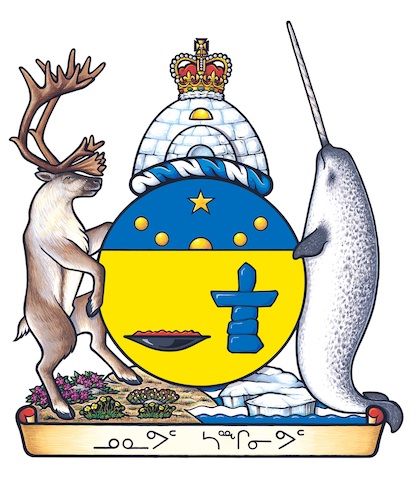Quick links
qulliq
< Inuktitut
DCHP-2 (Jun 2013)
Spelling variants:kudlik, kullik,
n. & adj. — Aboriginal (Inuit), Territories, especially Nunavut
a soapstone lamp fuelled by seal oil (see Image 1).
Type: 1. Origin — Qulliq is a borrowing from Inuktitut, one of the principal languages of the Inuit peoples of the Canadian north. The term is virtually unknown outside of Canada (see Chart 1). This traditional lamp is of great cultural significance, as it is one of the key symbols of Inuit culture, featuring in the inauguration ceremony on the occasion of the creation of the Nunavut Territory in 1999, and in the Nunavut coat of arms (see Image 2).
See also COD-2, s.v. "quiliq", which is marked "Cdn (North)", and OED-3, s.v. "kudlik", which is marked "Canad.".
See also COD-2, s.v. "quiliq", which is marked "Cdn (North)", and OED-3, s.v. "kudlik", which is marked "Canad.".
The qulliq appears on the coat of arms of Nunavut to the left of the inukshuk (see Image 2).
Note that we include the 1956 quotation because it is an early use. However, it's not clear why the quotation equated the lamp with the very different Primus stove (which uses kerosene as a fuel), unless the source of heat was not clear in the photograph that the quotation refers to.
Note that we include the 1956 quotation because it is an early use. However, it's not clear why the quotation equated the lamp with the very different Primus stove (which uses kerosene as a fuel), unless the source of heat was not clear in the photograph that the quotation refers to.
Quotations
1956
Preparing to have a meal of bannock being cooked by John Exsimak over a kudlik or primus stove are Maggie Hatuk, RCMP Cpl. Tom Aucherloni and Mary Penagusik inside cutaway igloo.
1981
(When she was a child she lived in a haunaq, a winterized tent of canvas over a frame floor, lined with moss, covered with snowblocks and heated by a kudlik, a lamp which burned seal oil. When she married Jonniebo the artist, her first husband, in 1947, they lived in a snowhouse.)
1992
It is Arctic winter now, but when light and warmth return there will again be a low structure on the playground, a wooden frame packed with moss for insulation and covered with protective canvas. Inside it, there are no desks or chairs, just low platforms thickly piled with bedding. Heat and light are supplied by the qulliq, a traditional lamp burning rendered seal blubber.
2002
She spoke about her childhood and the lifestyle of the Inuit culture.
She also lit the Qulliq, a traditional Inuit lamp that she uses during prayer.
2010
A kudlik (also known as a qulliq) is a traditional Inuit oil lamp. A kudlik was lit in a ceremony prior to the start of the Joamie School Christmas concert in Iqaluit, Nunavut, on December 15.
Sinea Kownirk is an Inuit elder. She works at Joamie School in the school's cultural program. She also bakes bannock and cooks for the school's breakfast program. She lit the school's kudlik at the concert.
The kudlik is an oil lamp carved of soapstone. It is crescent shaped and contains oil from seal or blubber. The wicks line the length of the crescent. The wicks are of natural materials found on the tundra and could be of moss or arctic cotton grass. Sinea used a stick (taken from a plant found on the tundra) to drop oil onto the wicks. Keeping the wicks oiled is a continuous process to keep the kudlik lit. The Inuit used kudliks for their lighting and heating source, as well as for cooking and drying clothing.
2012
Kullik-burning is a ceremonial Inuit tradition which involves the burning of oil in a soapstone lamp. Smudging is a First Nations purification ceremony involving the burning of sacred plants such as juniper, sage or sweet grass. Although these plants have distinct aromas, the smoke associated with smudging is minimal. Memorial University recognizes kullik-burning and smudging as important Aboriginal practices and therefore is developing a new policy which will allow for incorporation of these practices into campus life.
2016
It's up for debate as to whether Ottawa or Winnipeg has the largest population of Inuit outside the North, but Langille estimates that the capital boasts roughly 3,000. "It's a chance to make connections or reconnect and celebrate who we are, and have lots of fun," she said.
An elders tent featured a Coleman stove, a qulliq - a traditional oil lamp - and cups of tea, an olfactory combination that brought one woman to nostalgic tears. Elsewhere, children played on snowbanks, old friends hugged and talked, and everyone ate.
References
- OED-3
- COD-2
Images

Image 1: A woman with a qulliq. Source: Wikimedia Commons. Photo: A. Walk
